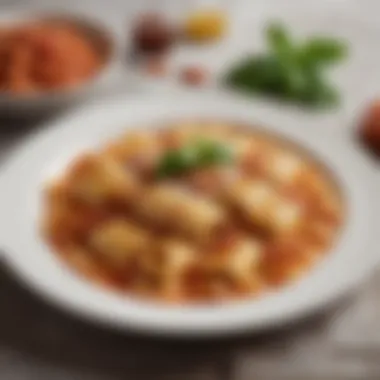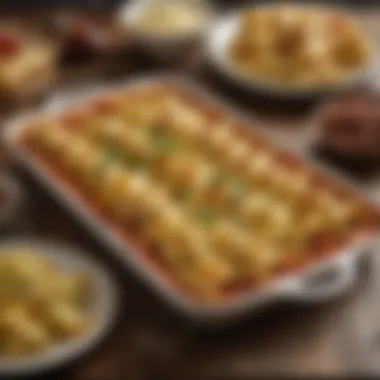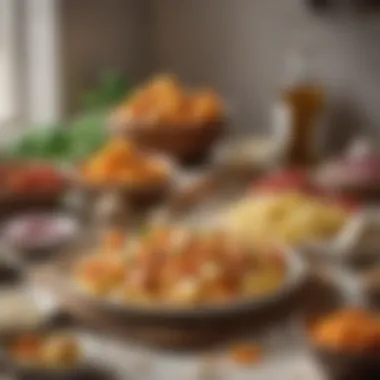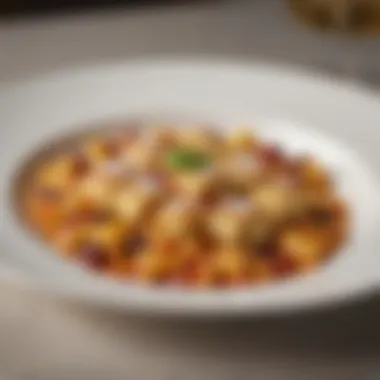Exploring Paccheri: A Versatile Italian Pasta Delight


Intro
Italian pasta has a remarkable capacity to transcend mere sustenance. Paccheri, the large tubular pasta, is especially distinctive due to its size and texture. Its origins are attributed to regions in southern Italy, particularly Naples. The structure of paccheri allows it to hold rich sauces and diverse fillings, making it well-suited for a wide range of dishes.
In recent culinary practices, paccheri has maintained its traditional charm while adapting to modern cooking needs. This flexibility makes it a valuable ingredient for time-constrained individuals. The simplicity of its preparation combined with its adaptability to various flavors and dietary preferences positions it uniquely in the kitchen.
This article_delves into the various forms, preparations, and creative uses of paccheri, providing both inspiration and practical knowledge for home cooks.
Recipe Overview
Paccheri al Pomodoro
- Number of portions: 4
- Time required: 30 minutes prep and cook
- Difficulty: Easy
- Main ingredients:
- Paccheri pasta
- Olive oil
- Garlic
- Canned whole tomatoes
- Basil
- Grated Parmesan cheese
Paccheri al Pomodoro is an easy yet flavorful dish. The simple tomato sauce perfectly complements the pasta's sturdy shape. As it cooks, the paccheri absorb the sauce, resulting in a satisfying and comforting meal.
Step-by-Step Instructions
- Prep the Ingredients:
- Cook the Pasta:
- Prepare Sauce:
- Combine:
- Finish:
- Mince 3 cloves of garlic.
- Wash and tear basil into small pieces.
- Open a can of whole tomatoes and crush with a fork for a chunky texture.
- In a large pot, bring salted water to a boil.
- Add the 400g paccheri and cook according to package instructions until al dente, usually around 12 minutes. Drain and set aside, saving 1 cup of pasta water.
- In a large skillet, heat 3 tablespoons of olive oil over medium heat.
- Add minced garlic and sauté until golden, about 1 minute.
- Stir in crushed tomatoes and cook for 10 minutes, letting the flavors meld.
- Add cooked paccheri to the skillet, tossing gently with the sauce.
- If sauce is too thick, gradually mix in saved pasta water to reach desired consistency.
- Stir in fresh basil just before serving.
- Serve immediately, topped with grated Parmesan cheese.
Time-saving strategies include cooking the pasta while preparing the sauce.
If pressed for time, canned tomatoes are suitable and do not compromise flavor.
Nutritional Information
- Total calories per portion: Approximately 400.
- Macronutrient breakdown:
- Proteins: 12g
- Fats: 15g
- Carbohydrates: 50g
Essential nutrients such as Vitamin C from tomatoes and calcium from Parmesan contribute to the dish’s nutritional profile, reinforcing its place in a balanced diet.
Quick Cooking Tips
- Kitchen gadgets: Utilize an electric stove for more precise temperature control while sautéing.
- Effective multitasking: Begin to boil the water at the same time as free the ingredients and prepare the sauce sections.
- Healthier alternatives: Swap out pasta for whole grain paccheri for added fiber. Consider using fresh tomatoes in lieu of canned for a fresh taste.
Related Recipes & Variations
- Paccheri with Spinach and Ricotta: Add sautéed spinach and ricotta filling as a twist.
- Pasta Bake: Use paccheri in baked dishes, layering with cheese and sauce.
- Vegan option: Replace Parmesan with nutritional yeast for a dairy-free alternative.


Feel free to explore different flavors and ingredients. Paccheri invites customization, expanding possibilities for culinary creativity. Share your unique recipe on reddit.com to inspire others.
Intro to Paccheri
Paccheri is a remarkable type of pasta that captures the essence of Italian culinary tradition. Understanding this pasta's unique characteristics and history is central to appreciating its versatility and cultural significance. In this section, we will explore what paccheri is, its intriguing history, and the regions in Italy renowned for producing this delicious pasta. This foundation is important for anyone looking to enhance their culinary repertoire or to simply enjoy a delightful meal.
Definition of Paccheri
Paccheri are large, tubular pasta shells, typically measuring about two inches in length and one inch in diameter. Their size and shape allow them to hold various types of sauces well, making them popular in many dishes. Global awareness of paccheri has increased in recent years, yet many people might still experience it purely as a individual ingredient rather than fully understanding its potential.
Historical Background
Nestled within the depths of Italian history, paccheri is believed to have originated in the Naples region. This distinct pasta likely influenced by various cultural exchanges throughout Italy's history. The term “pacchero” itself comes from the Neapolitan word “paccharo,” referring to “slap” or “stroke,” which may relate to how this pasta resembles a fun, hearty bite.
Paccheri’s culinary importance grew alongside its historical significance. It has been consumed during times of celebration, symbolizing abundance and family gatherings. In sum, understanding of its roots provide broader perspective on Italian cooking traditions.
Traditional Regions of Production
Paccheri is predominantly associated with Southern Italy. Regions like Campania, Apulia and Calabria are known for their quality pasta production. Artisanal methods often distinguish these regions from mass-produced counterparts found elsewhere. Many small-scale producers still make paccheri by hand, using wheat and water to shape this traditional pasta.
While Campania may be the best-known area for paccheri, other regions continue to innovate, adapting techniques and recipes that reflect local ingredients. Recognizing where paccheri comes from allows culinary enthusiasts to appreciate not just the pasta itself, but the history and craftsmanship behind it.
Understanding the Characteristics of Paccheri
Understanding paccheri involves an examination of its unique elements that contribute to its special place in the culinary world. Recognizing the shape, size, texture, and nutritional aspects of this pasta type enhances how it is prepared and enjoyed. By familiarizing oneself with these characteristics, one can appreciate how paccheri not only serves as a medium for sauces and fillings but also enriches meals with its distinctive qualities.
Shape and Size
Paccheri are large, tube-shaped pasta, measuring about 2 to 4 inches in length and typically 1 inch in diameter. Their considerable size allows paccheri to cradle a variety of ingredients, making them suitable for both stuffed dishes and as a base for hearty sauces. The wide opening makes it easy to fill with ingredients like ricotta, vegetables or meats, offering versatility for different regional recipes.
The design of paccheri also follows a historical lineage. Some believe its name originates from the Neapolitan term "paccheri", translating roughly to “slaps”, possibly referring to their size and shape. This relationship between form and function cannot be understated; the characteristics add distinct visual and texture appeal, whether presented on a plate or incorporated into more complex contexts.
Texture and Cooking Properties
Paccheri boasts a unique texture that provides an enjoyable mouthfeel. The slight ridges on the surface help dress sauces well—gripping flavor and preventing it from sliding off the acquired bite. This property is especially vital when serving with smooth sauces, such as a basil or tomato-based mix; paccheri becomes an agent enriching the overall dining experience.
When it comes to cooking, paccheri usually requires a longer time compared to smaller pasta shapes. Teaming it with some ample cooking liquid and careful monitoring is important. Overcooking can lead to a pasty texture that is far from pleasant. A great tip is to aim for al dente—the firm texture not only preserves flavor but stands up well under heavy sauces. Experimenting with cooking times can lead to different outcomes and enhance your reputation as a pasta aficionado.
Nutritional Profile
From a health perspective, paccheri generally features a mix of simple carbohydrates from wheat flour, making it an energy-rich food that offers quick energy release. When cooked, they often contain a low count of fat and provide a suitable amount of fiber.
For those more experimental in their culinary pursuits, whole grain varieties of paccheri improve the pasta's profile significantly. Whole grain options contribute more vitamins and minerals, giving individuals more choices that align with dietary preferences. Combining paccheri with a medley of colorful vegetables can enhance nutritional value and introduce a vibrant contrast.
Interestingly, experiments with various fillings, such as fresh vegetables blended with cheese or protein, can transform paccheri into a more nutritionally balanced dish by increasing protein intake while providing necessary vitamins and antioxidants.
In exploring paccheri, one grasps its culinary potential; its shape, texture, and nutritional content open doors for creativity while satisfying the palate. The trip into the specifics of paccheri thus lays firm grounding for further culinary adventures.
Cooking with Paccheri
Cooking with paccheri is essential to fully appreciate its uniqueness and versatility within Italian cuisine. This section focuses on important elements that make paccheri an exciting option for home cooks. Selecting the right ingredients, employing effective cooking techniques, and avoiding common pitfalls are key factors that influence the final dish.


Selecting the Right Ingredients
The quality of ingredients used when cooking paccheri can greatly affect the outcome of the dish. Here are some tips for choosing the right components:
- Pasta Quality: Opt for high-quality bronze-extruded paccheri. It has a rough texture that better holds sauces.
- Sauce Pairings: Consider rich sauces that complement the pasta's large surface area. Tomato-based sauces, creamy concoctions, or a vibrant pesto work excellently.
- Fresh Ingredients: When adding vegetables, proteins, or herbs, always select fresh, seasonal options to enhance flavor and nutrition.
This intentional selection not only improves taste but also adds aesthetic appeal to the final presentation.
Basic Cooking Techniques
Understanding basic cooking techniques is vital for making paccheri properly. Here are essential steps to consider:
- Boiling Water: Fill a large pot with water and bring it to a rapid boil, allowing the paccheri to cook evenly. Concentrate on the following rules:
- Cooking Time: Follow the cooking time suggested on the package but check for an
- Use plenty of water to prevent sticking.
- Add salt to enhance flavor.
Quick and Easy Paccheri Recipes
Quick and easy paccheri recipes are essential for busy cooks seeking efficient yet flavorful meal options. This section highlights various simple recipes that one can prepare without spending extensive time in the kitchen. Each recipe brings out the unique characteristics of paccheri, allowing its versatility to shine through while still being approachable for all skill levels. These recipes do not require any special cooking techniques, making them ideal for those who enjoy comforting meals with minimal effort.
Paccheri with Tomato Sauce
This classic dish is a staple in many Italian households. Its simplicity allows the flavors of the ingredients to meld beautifully, creating a satisfying meal. To prepare, cook the paccheri until al dente, following the package instructions.
For the sauce, heat olive oil in a pan and sauté minced garlic until fragrant. Add crushed tomatoes, salt, and fresh basil. Simmer this mixture for about 20 minutes. Once the pasta is ready, combine the paccheri with the sauce, stirring gently to coat each piece. Adding freshly grated Parmigiano-Reggiano at the end elevates the dish.
Pro Tip
Always taste your sauce and adjust seasoning with salt or pepper for the desired flavor profile.
Paccheri with Ricotta and Spinach
This recipe is perfect for a quick but nourishing meal. Start by boiling the paccheri, then drain them and set aside. In a separate bowl, mix fresh ricotta with cooked spinach, nutmeg, and salt. Fill each paccheri piece with this ricotta mixture. Arrange in a baking dish, cover with tomato sauce, and sprinkle with mozzarella. Bake at a preheated oven for around 25 minutes until golden.
The blend of ricotta’s creaminess and spinach’s mild earthiness creates a delightful contrast with the pasta's chewiness. This dish is not just quick to prepare; it also packs nutrients, making it a family-friendly option.
Baked Paccheri
For those who enjoy baked pasta dishes, paccheri can easily be adapted. Start by preparing the pasta al dente in boiling water. In an ovenproof dish, layer the bottom with a rich tomato sauce and arrange a layer of paccheri.
Above this, add a mix of sautéed mushrooms and chicken or zucchini. Pour more sauce over and sprinkle cheese. Repeat these layers until all ingredients are used. Bake in the oven at 375°F for about 30 minutes, or until bubbly and golden on top. The result is a full-bodied meal the whole family will enjoy.
Paccheri Seafood Pasta
Seafood lovers will delight in this quick dish. Use a mix of shrimp, mussels, and squid. Start by cooking the paccheri while you prepare the seafood separately. Sauté garlic and onion in olive oil, then add the seafood, a splash of white wine, and fresh herbs.
The seafood cooks quickly, so by the time the paccheri is done, you can combine them and serve immediately. Finish with a drizzle of olive oil and a squeeze of fresh lemon for brightness. This dish represents the coastal depth associated with traditional Italian cuisine.
Paccheri in Modern Cuisine
Paccheri is carving out a notable place in contemporary culinary scenes. This iconic pasta is not only cherished for its historical roots but is also celebrated for its adaptability in modern recipes. The unique shape of paccheri serves as a canvas, inviting various flavors and textures and thus enhancing creative cooking. As culinary enthusiasts seek to innovate their meals, paccheri's role broadens beyond traditional dishes, making it an essential ingredient in diverse cuisines.


Its robustness allows it to hold up against both light and rich sauces, making it versatile for many culinary applications. This characteristic is especially important for cooks wanting to create satisfying meals without lengthy preparation time. Recognizing its ability to bridge dishes from different cultures spurs a fresh exploration of possibilities.
Fusion Recipes
The intersection of Italian and other global cuisines can be found in Fusion Recipes. These dishes give paccheri a multidimensional aspect. Home cooks can play with ingredients that fuse traditional flavors with novel culinary techniques. For example, a paccheri dish can incorporate Thai basil, braised pork, and a coconut sauce, transforming this humble pasta into an exotic meal.
Some key fusion combinations include:
- Paccheri with Curry Chicken: A blend of Italian classic with Indian spices, creating a flavorful dish.
- Paccheri with Pesto and Hummus: Mixing classic Italian pesto with Middle-Eastern hummus for a creamy twist.
These innovative dishes illustrate how paccheri adapts well, lending itself to a variety of culinary traditions while maintaining its essential Italian heritage. Cooking increasingly demands quick but quality solutions, and these fusion recipes do exactly that.
Creative Flavor Pairings
The magic of paccheri also comes from Creative Flavor Pairings. Thoughtful ingredient combinations elevate the dining experience. Paccheri’s large cylindrical shape works beautifully with fillings and accompaniments. Ideal flavor pairings can broaden the appeal and sophistication of a dish.
Here are some noteworthy pairing ideas:
- Seafood: Incorporating shrimp or scallops in a light garlic sauce creates an elegant offering.
- Vegetables: Roasted bell peppers and zucchini can complement paccheri perfectly, adding a contrast of textures and a burst of color.
- Cheese: Pairing with rich cheeses like gorgonzola or a sharp pecorino enhances flavor depth.
Using these flavor combinations encourages cooks to be adventurous, creating meals that may taste complex yet are quite easy to prepare. Even minimalists can experiment with adding herbs or citrus that will freshen these combinations, ensuring tantalizing results.
Exploring new ingredients alongside paccheri can lead to surprising and enjoyable culinary experiences.
Serving Suggestions
Serving suggestions play an essential role in the overall dining experience when it comes to paccheri. Their unique shape lends itself well to both diverse ingredient pairings and impeccable presentation. Effective serving methods elevate the perception of the dish and improve flavor pairing outcomes. When attended to robustly, these elements reflect the culinary context from which paccheri originated.
Ideal Accompaniments
Pairing paccheri with complementary flavors enhances its delightful nature. Here are some ideal accompaniments:
- Sauces: Paccheri pairs well with hearty sauces that can fill its tubular shape. Tomato-based sauces, meat ragù, or creamy basil pesto are some classes of good options.
- Proteins: Incorporate proteins like grilled chicken, shrimp or even lentils to achieve roundsin balanced nutrition.
- Vegetables: Fresh vegetables like spinach, zucchini, and bell peppers counterbalance the pasta well. Roast or sauté these for an added flavor dimension.
- Cheese: Cheese selections play a crucial role. Grated Parmigiano-Reggiano or ricotta can delicately enrich the dish.
Ideal accompaniments should offer variety without overwhelming the pasta. Clean flavors thus allow the delicious characteristics enriched inside every paccheri to shine.
Presentation Tips
A well-presented plate captivates interest before the first bite. Follow these tips for enticing presentations:
- Plate Size: Choose appropriately sized plates. A larger plate allows for a sparse, artful arrangement rather than overcrowding the pasta, permitting eyes to wander.
- Garnishing: Fresh basil leaves, chili flakes or a drizzle of olive oil look good as final touches and boost aroma.
- Height Structure: Introducing height creates visual interest. Position paccheri standing vertically or arrangement in layers to mesmerize your guests.
- Napkin Art: Using cloth napkins artistically tucked around plate edges substantiates a sophisticated atmosphere.
Utilizing these presentation tips can create a pleasurable overall experience, making paccheri not just a dish on a plate but a form of culinary artistry.
Epilogue
In the realm of culinary arts, paccheri stands out, merging tradition with modern experiences. Its large tubular form not only enhances visually, but also plays a practical role in binding sauces, creating layers of flavor in each bite. This particular pasta appeals to both home cooks and professional chefs, due to its versatility and ease of preparation.
With paccheri, culinary enthusiasts can explore diverse recipes, embracing rich regional traditions or inventive modern variations. The forgiving nature of this pasta makes it forgiving during cooking, which is crucial for those pressed for time.
Ultimately, paccheri symbolizes how diving deep into a single ingredient can reveal an unexpected depth and richness in taste, culture, and enjoyment.
Recap of Paccheri's Appeal
Paccheri's allure springs from several factors. Its noteworthy characteristics include:
- Shape and Texture: The wide-open ends and substantial texture hold sauces remarkably well.
- Preparation Flexibility: It can be used in various cooking styles, from simple to complex, accommodating tastes from a range of palates.
- Historical Significance: The stories and traditions behind paccheri connect us to the heart of Italian cuisine.
Each of these components leads to a gratifying experience when incorporating paccheri into meal planning. This pasta has rooted itself in many cooking pedidikan as the capacity for creativity expands.







